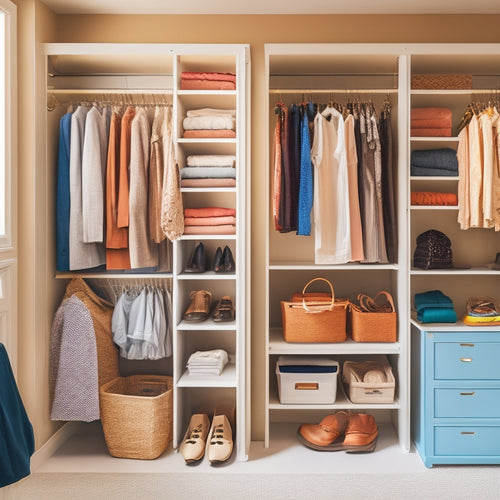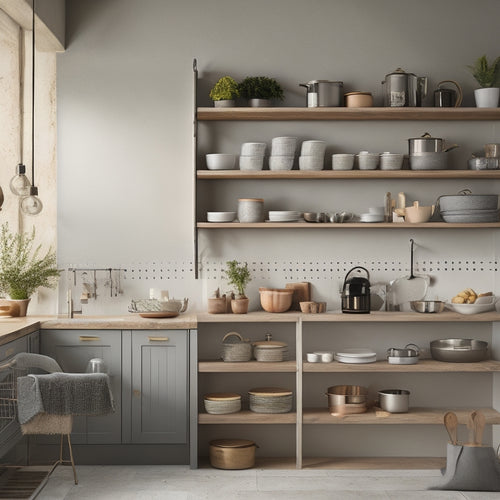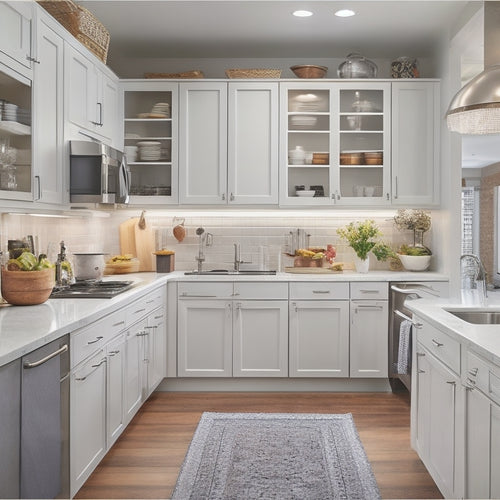
7 Essential Cabinet Organization Hacks
Share
You're sitting on a cache of wasted space in your cabinets, and it's time to tap into it. Maximize your vertical storage space with stackable containers and adjustable shelves. Employ corner cabinets with lazy Susans and carousel organizers. Optimize shelf dividers and bins to categorize items, and store heavy ones below countertops. Implement a spice rack system, designate a junk drawer zone, and label each section clearly. By incorporating these 7 essential organization hacks, you'll change the way you store, retrieve, and employ your kitchen essentials - and uncover even more efficient ways to streamline your kitchen workflow.
Key Takeaways
- Maximize vertical storage space by using stackable containers, adjustable shelves, and carousel organizers to store more items efficiently.
- Utilize corner cabinet solutions like lazy Susans and blind corner shelves to increase storage capacity and accessibility in tight spaces.
- Implement a labeling system with clear and descriptive labels, and consider color-coding or icon-based labels for similar items.
- Optimize shelf dividers and bins to create manageable areas for organized storage, and allocate lower shelves for heavy items.
- Establish regular maintenance and organization routines to prevent clutter buildup and keep cabinets functional and tidy.
Maximize Vertical Storage Space
With cabinet space at a premium, making the most of your vertical storage is essential. You can't afford to waste a single inch.
To maximize your cabinet's vertical space, invest in stackable containers that can be easily rearranged as your storage needs change. By implementing a structured filing system effective file and paper management and optimizing your kitchen layout, you'll be able to free up more space for storage.
Adjustable shelves are also a transformative element, allowing you to customize the layout to fit your unique storage requirements. By using these tools, you'll be able to store more items in a smaller footprint, freeing up useful space for other essentials.
Take control of your cabinet's vertical space and make the most of it – your organized kitchen will thank you!
Utilize Corner Cabinet Solutions
Now that you've optimized your cabinet's vertical space, it's time to tackle the often-wasted space in the corners. Corner cabinets can be challenging, but with the right solutions, you can turn them into worthwhile storage areas.
| Corner Cabinet Solution | Benefits |
|---|---|
| Corner Shelves | Increases storage capacity and accessibility |
| Lazy Susan | Allows easy access to items in the back of the cabinet |
| Carousel Organizer | Maximizes storage in tight spaces |
| Adjustable Corner Shelf | Customizable to fit your specific needs |
| Blind Corner Shelves | Makes use of hidden space in blind corners |
Optimize Shelf Dividers and Bins
You're now ready to optimize your shelf space by dividing it into manageable areas using shelf dividers and bins.
This will help you conquer clutter and make the most of your cabinet's vertical storage.
Divide and Conquer Space
Optimizing shelf dividers and bins is a game-changing factor in cabinet organization, as it enables you to carve out a functional space that's customized to your specific needs. By dividing your cabinet into separate compartments, you can assign a home for each item, making it easier to find what you need when you need it. This is particularly useful for drawer organizers, where dividers can keep utensils, cleaning supplies, or cookware organized and accessible.
| Cabinet Style | Divider Type | Benefits |
|---|---|---|
| Modern | Adjustable dividers | Flexibility to accommodate items of varying sizes |
| Traditional | Fixed dividers | Creates a sense of structure and stability |
| Custom | Bins and baskets | Adds a touch of personality to your cabinet organization |
Utilize Vertical Storage
Your cabinet's vertical space is a precious real estate that can be employed to maximize storage capacity. By optimizing shelf dividers and bins, you can make the most of this space.
Install vertical dividers to separate items and prevent shelf stacking, which can lead to clutter and disorganization. This will also make it easier to find what you need at a glance.
Consider using stackable bins or baskets to store items like cleaning supplies, linens, or kitchen utensils. Label each bin so you can quickly identify its contents.
Store Heavy Items Below Countertops
You'll find it's more practical to store heavy items, like pots and pans, below countertops where they're easily accessible.
Allocate lower shelves for these items to free up upper shelves for lighter, less frequently used items.
Heavy Item Placement
The kitchen's heaviest items, such as stand mixers and slow cookers, can quickly clutter countertops and make the space feel cramped. To maintain a sense of control and organization, it is crucial to store these items below countertops. This not only frees up counter space but also guarantees heavy item safety and promotes proper lifting techniques.
| Heavy Item | Optimal Storage Location |
|---|---|
| Stand Mixer | Bottom shelf of a cabinet or pantry |
| Slow Cooker | Lower cabinet with easy access |
| Blender | Under-sink storage or a designated appliance garage |
Lower Shelf Allocation
By allocating lower shelves for heavy items, you're creating a safer and more organized kitchen. This strategic placement prevents straining and reduces the risk of accidents.
Heavy pots, pans, and appliances should be stored below countertops, where they're easily accessible without having to stretch or climb. Consider the shelf height and adjust it according to your needs. This will also free up space in your upper cabinets for lighter, less frequently used items.
Additionally, this allocation allows for more efficient drawer organization, as you can reserve the top drawers for utensils and gadgets, keeping them within easy reach.
Countertop Clearance Zones
Designate countertop clearance zones to prevent clutter and maintain a smooth workflow. This means storing heavy items, like stand mixers and blenders, below countertops.
By doing so, you'll create a clear path for food preparation and cooking, allowing you to focus on the task at hand. A clutter-free countertop also enhances the kitchen's aesthetic appeal, making it a more enjoyable space to work in.
As you allocate these zones, consider your kitchen workflow and prioritize the items you use most frequently. Store them in easy-to-reach locations, keeping your countertops clear and organized.
This simple hack will revolutionize your kitchen's functionality and make cooking a breeze.
Implement a Spice Rack System
About twenty spices and seasonings are likely cluttering your cabinet shelves, making it difficult to find what you need when cooking. You can't afford to waste time searching for that one specific spice jar.
To regain control, implement a spice rack system. Install a wall-mounted or in-cabinet spice rack to maximize storage and visibility. Organize your spice jars by frequency of use, alphabetical order, or category (e.g., baking, savory).
Consider a tiered system for spice blend storage, keeping similar blends together. Label each jar and the corresponding shelf or section to guarantee easy identification.
With a well-organized spice rack system, you'll be whipping up meals in no time, and your cabinet space will breathe a sigh of relief.
Designate a Junk Drawer Zone
Your kitchen cabinet space is precious real estate, and it's time to reclaim it from clutter. By designating a junk drawer zone, you'll create a space for miscellaneous items that don't have a designated home. This zone will help maintain order in your kitchen and reduce stress.
To set up your junk drawer zone, consider the following essentials:
-
Divided compartments: Use inserts or dividers to separate items into categories, such as batteries, twist ties, or takeout menus.
-
Small storage bins: Add small bins or containers to store items like pushpins, paper clips, or safety pins.
-
Adhesive hooks: Attach hooks to store items like scissors, tape, or small kitchen gadgets.
- A "maybe" box: Designate a box for items you're unsure about keeping or donating, and set a deadline to review its contents.
Label and Sign Cabinet Contents
Take control of your cabinet's contents by labeling and signing what's inside. You'll be amazed at how this simple step can change your content organization.
Use clear and descriptive labeling techniques to identify what's stored in each cabinet or shelf. This way, you'll quickly find what you need without having to dig through everything.
Consider using labels with icons or colors to categorize similar items. For example, label all cleaning supplies with a blue label or a cleaning icon.
Sign your labels with the contents or category, ensuring everyone in the household knows what's inside. This system will save you time and reduce clutter.
With labeled and signed contents, you'll maintain a sense of control and order in your cabinet space.
Frequently Asked Questions
How Do I Clean Stuck-On Grease From Cabinet Shelves and Walls?
You'll tackle stuck-on grease on cabinet shelves and walls by employing effective grease removal techniques, such as baking soda and water or white vinegar and lemon juice, as natural cleaning solutions that won't damage surfaces.
What Is the Best Material for DIY Cabinet Organizers?
When choosing DIY cabinet organizers, you'll balance style and functionality by considering wood options like cedar or pine, and plastic alternatives like acrylic or PVC, each offering unique benefits for durability, ease of cleaning, and aesthetic appeal.
Can I Use Adhesive Magnets on Painted Cabinet Surfaces?
You can use adhesive magnets on painted cabinet surfaces, but choose magnets with a strong acrylic or foam adhesive that won't damage the paint, and guarantee the surface is clean, dry, and free of oils or waxes.
How Do I Measure for Custom Cabinet Inserts Accurately?
To measure for custom cabinet inserts accurately, you'll need the right tools, like a tape measure, level, and caliper. Choose the cabinet insert type that fits your needs, then take precise measurements to guarantee a snug fit, considering factors like shelf depth and drawer dimensions.
Are Soft-Close Cabinet Hinges Worth the Extra Cost?
You're wondering if soft-close cabinet hinges are worth the extra cost. They offer benefits like reduced door slamming, quieter operation, and increased durability. While installation can be more complex, the payoff is a more refined, controlled experience, making the added expense a worthwhile investment for you.
Related Posts
-

Free Printable Closet Organization Checklists for Success
You're ready to tackle your closet clutter and create a peaceful space that sparks joy. A free printable closet organ...
-

Build Compact Kitchen Shelves in 5 Steps
You can create a compact kitchen shelf that maximizes storage and efficiency in just five easy-to-follow steps. First...
-

Why Narrow Kitchens Need Space-Saving Solutions
In your narrow kitchen, every inch is precious real estate. You know how quickly clutter can take over, making meal p...


